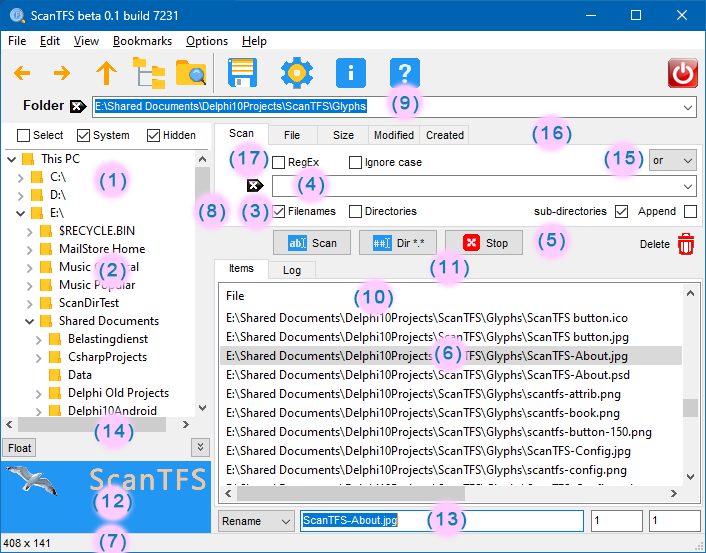ScanTFS - Help
Working with ScanTFS
Please be patient while the ScanTFS online Help is being updated and extended...
Getting started
To prepare your search, select the drive (and folder) from the Directory tree. Next specify one or more search arguments, indicate whether or not to include sub-directories and hit the [SCAN] button to start the search. Alternatively, the [Dir *.*] button will display all files in the current directory (ignoring any search arguments).The results of the Scan (search) are displayed as a list of file- and/or folder names (the Item list). All (or selected) files and folders in the Item list can be Renamed, Copied, Moved or Deleted. Instead of deleting files they can be emptied (the contents is removed and an empty file remains). It is also possible to change the following file attributes: Read-Only, Hidden, System, Archive, Date modified and Date created. Individual entries in the Item list can be moved up or down, or removed from the Item list (removed items are NOT deleted, they are only removed from the list). With ScanTFS you can (pre)View text- and image files, Open (run) program files and generate a CRC32, MD5 or SHA256 checksum for selected files. The CRC32 and MD5 checksums can also be used during rename, saved as a text file or copied to the clipboard. Right-click in the item list to view all available options. The entire item list can be Saved (exported) as a text file.
The Rename function includes automatic numbering of files and folders, extend filenames with one or more path levels, add a date stamp, extend or truncate filenames, add, change or remove the extension. There are multiple ways to modify the text case. The Rename function can also be used to generate Bates numbers for a range of files. Consider using the $RND directive to insert a 32 character random text string. A limited Rename function is available in the Copy/Move dialog.
→ Select one of the chapters on the left to read more about a specific subject or scroll down for a "fast start".

A 'fast start' to help you with ScanTFS without going through all the documentation:
(1) Expand a drive from the directory tree. Right-click to display the directory Tree PopUp menu.(2) Select a directory from directory tree. Click on a directory to switch to that directory. Right-click to display the directory Tree PopUp menu.
(3) Select if filenames and/or directory entries are listed and if sub-directories should be scanned.
(4) Specify string(s), mask(s) or Regular expression as search argument. Refer to file selection criteria for more information about file selection.
(5) Click the [Scan] button to start searching for filenames that match the search argument;
Right-click the [Scan] button to display a PopUp menu with pre-defined scan strings;
Click the [Dir *.*] button to display the contents of the current directory;
Click [Stop] or hit Esc key to interrupt a scan;
(6) The search results are displayed in the item list. Right-click to display the item list PopUp menu. You can: Purge, Delete, Rename, Copy, Move, Empty, Save, etc... the filenames in the item list.
Remarks
(6) The item list contains the filenames (and/or directory entries) that were found as a result of the last scan operation(s). Each entry in the item list has the following layout: Attribute | Volume | drive:pathname | filename | filesize | filedate. The Attribute is '.' for a directory entry and ':' for a filename.(7) The status bar displays informational messages. Interface.
(8) The splitter-bar divides the main window into two parts. Drag to the left or right to resize.
(9) The address bar also can be used to specify (paste) a pathname, hit [enter] to switch to the specified directory.
(10) click a Column title to sort on Path, File, Size, Modified or Created.
(11) click a Tab to switch between: Items or Log.
(12) use Ctrl+Alt+V to toggle Preview pane.
(13) use Ctrl+Alt+R to toggle Rename pane.
(14) drag the splitter-bar up or down to resize between the Preview pane and the Directory Tree.
(15) Indicate how (multiple) strings should be interpreted.
(16) Click tabs to specify more selection options.
(17) Check if the search argument contains a regular expression.
© 2018-2025 Skybird communications - modified: June 10, 2024 13:55:56